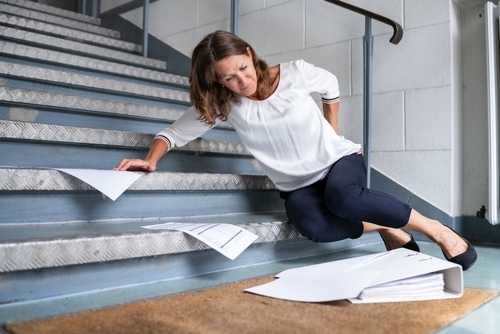Fault in a slip and fall accident refers to determining who is responsible or liable for the accident and the resulting injuries. Various parties, including property owners, business owners, and employers, can be at fault for these accidents.
Establishing fault is crucial to pursuing compensation from the at-fault party, and to prove it, you must showcase that someone was negligent in their duty of care to ensure the safety of others. This negligence can take many forms, from failure to eliminate a known hazard to not providing adequate warning signs.
The process requires careful evaluation of the accident, using evidence to establish four key elements. Between varying state laws and common tactics designed to shift the blame to the victim, having help from a skilled lawyer is essential.
Who Could Be At Fault in a Slip and Fall Accident?
Numerous parties can be at fault for your slip and fall accident, and pinpointing who is to blame comes down to factors surrounding your accident.
For example, suppose Kelly was walking through a grocery store, browsing for items on her weekly shopping list. Up ahead, there’s a spill on the floor, left unaddressed by management. Unfortunately, since there was nothing to indicate the hazard, Kelly didn’t notice until she slipped and fell, resulting in various injuries.
In this particular example, the business owner could be responsible for Kelly’s injuries.
In other instances, the negligent party could be an employer who failed to eliminate a known hazard or a property owner who didn’t prevent a dangerous property condition. Common causes of slip and fall accidents can vary, from spills in grocery stores to unsafe conditions on someone’s property.
It all depends on the circumstances specific to your accident, including where and why it happened. A skilled lawyer can help you determine who is to blame and pursue compensation.
Establishing Fault in Slip and Fall Accidents
Understanding the role of negligence in slip and fall accidents is essential. To pursue compensation from the at-fault party, you must establish fault and showcase how their actions resulted in your injuries.
Four elements help establish fault in these cases: duty of care, breach of duty, causation, and damages. Your lawyer must prove each element, connecting the dots to showcase how the negligent party’s actions caused your injuries.
Duty of Care
Your lawyer must establish the at-fault party owed you a duty of care. In our grocery store example, the business has a duty to keep customers safe from dangers.
Breach of Duty
After establishing the duty of care, the next step involves showcasing how the negligent party breached this duty. In Kelly’s slip and fall accident in her local grocery store, her lawyer would demonstrate how the business’s failure to address the spill or put up signage breached the duty of care.
Causation
In this step, your lawyer begins connecting the dots. They will establish how your injuries wouldn’t have occurred but for the negligent party’s actions. In Kelly’s case, if the grocery store had adequately addressed the spill, she wouldn’t have slipped and injured herself.
Damages
Lastly, your lawyer will show the extent of the damages associated with the accident. These damages can include both economic and non-economic aspects of your case.
Economic damages apply to financial losses associated with your case, including medical bills, rehabilitation expenses, lost wages, and loss of future earning capacity. Conversely, non-economic damages aren’t financial and apply to non-quantifiable aspects of your accident, including loss of enjoyment of life, pain and suffering, and mental anguish.
Compensation caps on certain types of damages may apply in certain states, but this varies from one to the next.
What Evidence Do I Need in a Slip and Fall Lawsuit?
Evidence plays a pivotal role in slip and fall lawsuits. The types of evidence available may vary from one accident to the next. For example, the role of security footage in slip and fall accidents can be essential to showcasing that the accident wasn’t your fault.
Aside from security footage, other evidence, including witness statements, photos of the accident scene, expert testimonies, and pictures of your injury, can help build your case.
Gathering evidence for fault determination is essential in proving negligence in a slip and fall accident, so if possible, collect as much as you can. After your accident, take photos of the scene, document your injuries, and take witness statements and contact information.
Talk to Our Experienced Slip and Fall Accident Lawyers Today
Navigating the aftermath of a slip-and-fall accident can be daunting, especially when you’re dealing with a severe injury. The legal system can be complex, and laws surrounding negligence can further complicate the situation.
This is where our experienced personal injury lawyers at Jezic & Moyse come in. We’re well-versed in slip-and-fall accident cases and can help you navigate the intricacies of your case. Contact us at (240) 292-7200 or complete our online contact form for personalized help with your case.

